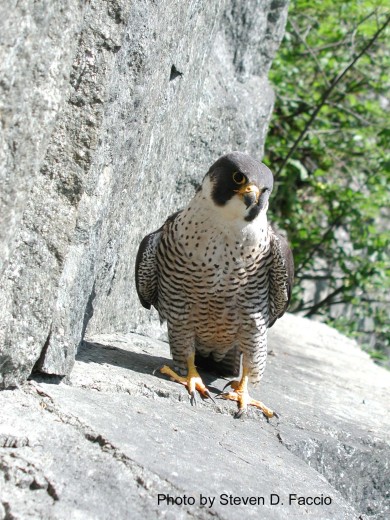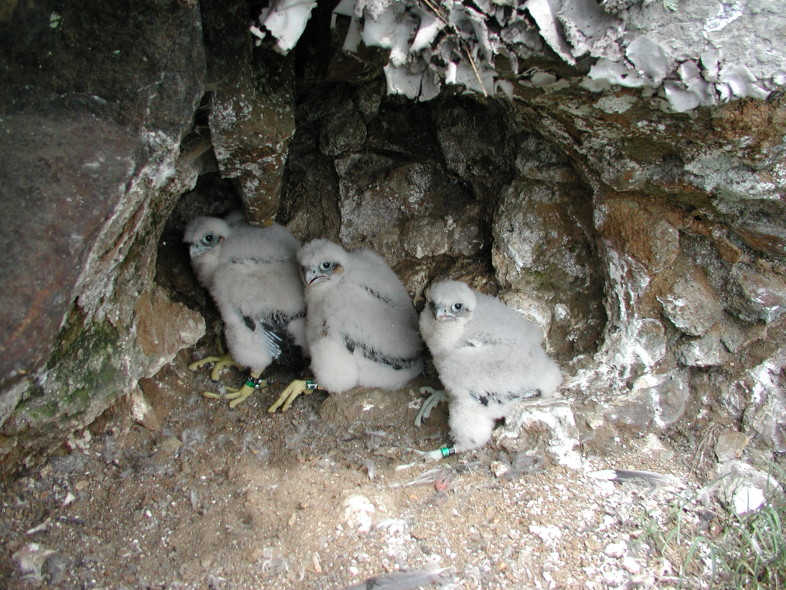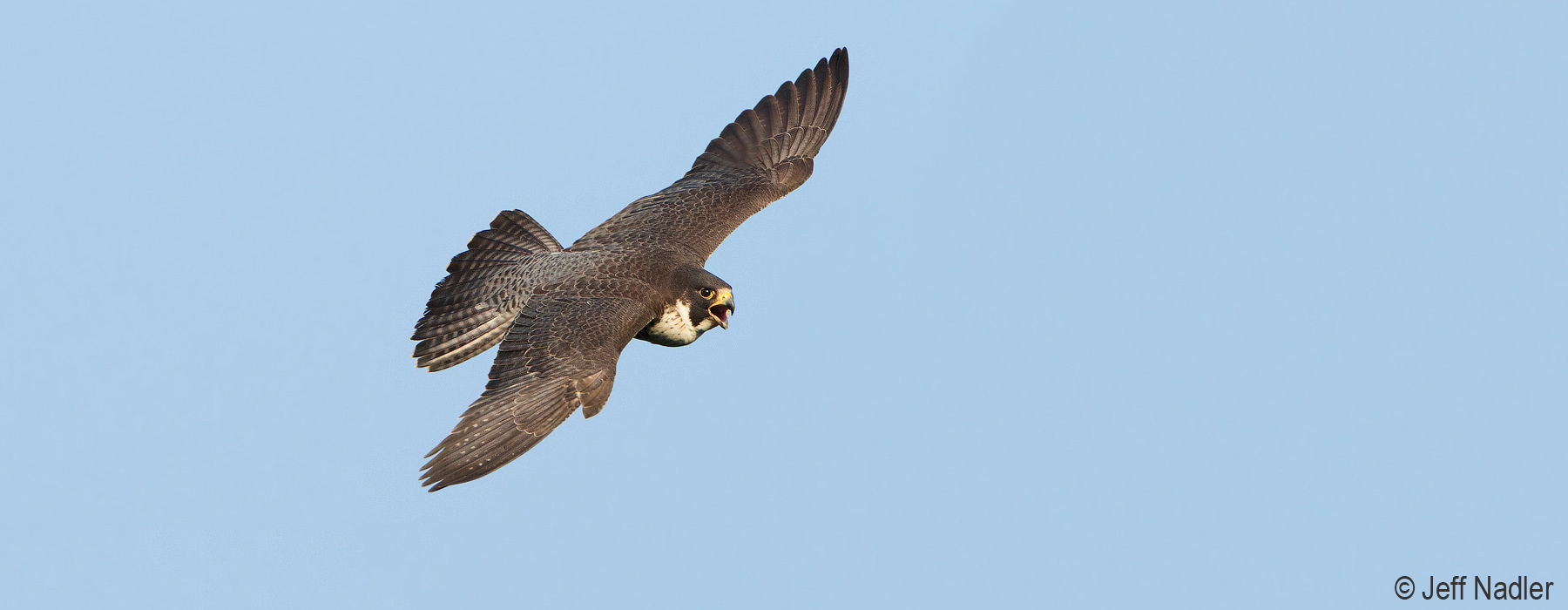Faster than a speeding train. Able to leap the Green Mountains in a single bound. It's a bird. Not a plane. It's a Peregrine Falcon!
When asked to name the fastest animal on earth, many people will respond “cheetah.” But it is the Peregrine Falcon – a cliff-dwelling raptor –that holds that title with the ability to reach speeds of 200+ MPH as they stoop in flight. Equally remarkable is the fact that this speed daemon of the skies was nearly wiped out 50 years ago; its recovery ranks among the great success stories of conservation biology and endangered species management.

Adult female Peregrine Falcon, Fairlee Palisades, May 20, 2004
Saving a Species
Historically, the eastern Peregrine Falcon population was centered in New England and the Adirondack Mountains, ranging south along the spine of the Appalachians to western Georgia. In 1940, the population was estimated at 350 pairs; by the mid-1960s, the species was completely gone from the region, a victim of the devastating pesticide DDT. Today, thanks to a highly successful reintroduction and management program, the species has been removed from the federal list of endangered species, though it remains listed as “threatened” in New Hampshire. It was removed from Vermont’s list in 2005.
The road to recovery began in the early 1970s with the establishment of the Environmental Protection Agency, which banned DDT in the U.S. The Endangered Species Act of 1973 provided protection and much-needed funds for a peregrine recovery program. Around the same time, the technique of breeding peregrines in captivity was perfected, providing a source of birds that could be reintroduced into their vacant range.
In New England, approximately 300 captive-bred peregrines were released during the late-1970s and 1980s at 17 different sites in Massachusetts, New Hampshire, Vermont, and Maine. The reintroduced population grew slowly at first: by 1991 there were just 22 nesting pairs. During the last 20 years, however, New England’s peregrines have undergone a population boom, with an estimated 114 breeding pairs fledging 150 young in 2010. In addition, the use of buildings, bridges, quarries, and other human-made structures for nesting is now widespread, especially in urban areas, where the species only infrequently nested prior to reintroduction.
Banded for Life
In the early 1990s, VCE biologist, Steve Faccio, began working with colleagues to place numbered aluminum bands on Peregrine Falcon chicks’ legs at nest sites across New England, allowing us to identify individual birds should they be encountered later. Through banding, we have gained insights into falcon movements and dispersal patterns, causes of mortality, and survivorship.
Between 1990 and 2009, we banded 986 nestlings in the six New England states. Of those, 238 (24 percent) were encountered at least once after banding. Most were seen in New England, but nearly 25 percent were found outside the region, including in eight eastern states, three Canadian Provinces, and one bird each in Cuba and Nicaragua. The young male found in Cuba had traveled 1,675 miles from its natal site in Acadia, Maine, the bird in Nicaragua had traveled 2,305 miles from its nest site on Mount Horrid in Vermont.

Recently banded chicks on Nichols Ledge, Vermont. / © Steve Faccio
Of the 238 encountered after banding, 50 were re-sighted at breeding territories across the eastern U.S., with the majority of those (39) returning to New England. There was a strong tendency for peregrines to settle at nest sites similar to those on which they were raised (e.g., those hatched on cliffs were more likely to nest on cliffs, while those from urban sites tended to nest on urban structures). However, movement between habitats was also documented.
On average, female peregrines dispersed farther than males with an average dispersal distance of 149 miles, compared to 104 miles for males. Such female-biased dispersal is widespread among birds. Since males must locate and defend a vacant territory, they will presumably have an advantage if they select a site close to “home.”
Our data also revealed that New England peregrines have strong site fidelity to a nest site. Banded birds returned to the same nest for an average of four years, with some staying at the same site up to 11 years. This is not surprising, given that suitable nesting cliffs are relatively rare, and a really good cliff – with multiple ledges to choose from and abundant prey nearby – is worth fighting for. In fact, there have been numerous cases in which resident adult females waged serious battle with intruding peregrines. In at least three of those cases, the resident bird was killed by the female interloper who then took over the nest site and paired with the resident male, prompting my colleague Tom French to quip to a reporter, “peregrines may mate for life, but they don’t mourn for a moment.”
Twenty years ago few of us could have imagined the success this project would enjoy. Peregrine falcons have reoccupied the majority of their historic breeding sites in New England, as well as many new sites. In fact, it is difficult to predict the region’s current carrying capacity, given the widespread use of human-created habitats for nesting. Yet, in the face of this resounding success, we must all remember that humans wrote this script, and the play’s still unfolding.
More Information
- Audubon Vermont Peregrine Falcon Recovery Project
- Map of Vermont Breeding Sites
- Vermont Breeding Bird Atlas I: 1976-1981
- Vermont Breeding Bird Atlas II: 2003-2007
VCE Science
Faccio, S.D., M. Amaral, C.J Martin, J.D. Lloyd, T.W. French, and A. Tur. 2013. Movement patterns, natal dispersal, and survival of Peregrine Falcons banded in New England. Journal of Raptor Research 47(3):246–261. (Abstract)

